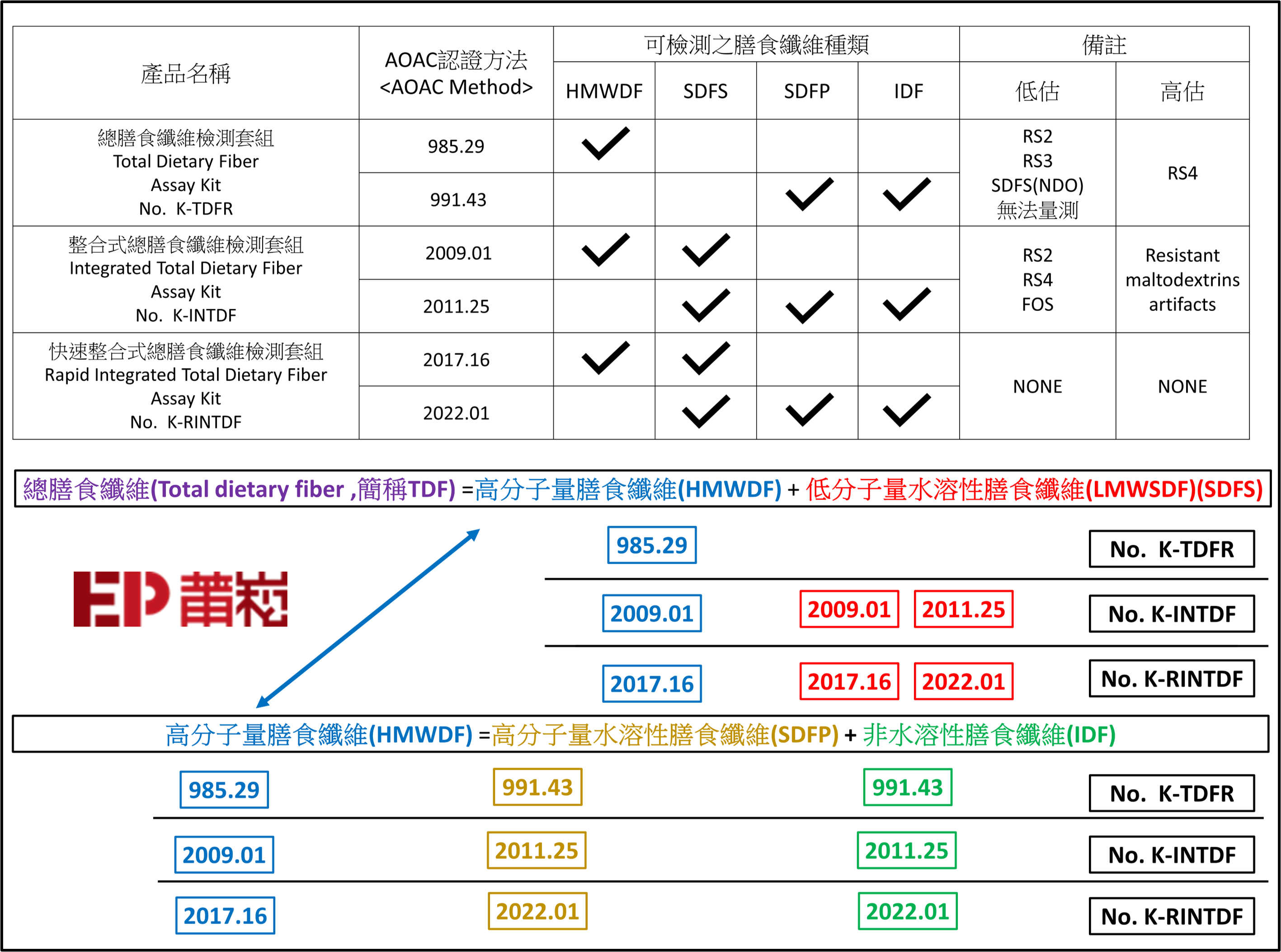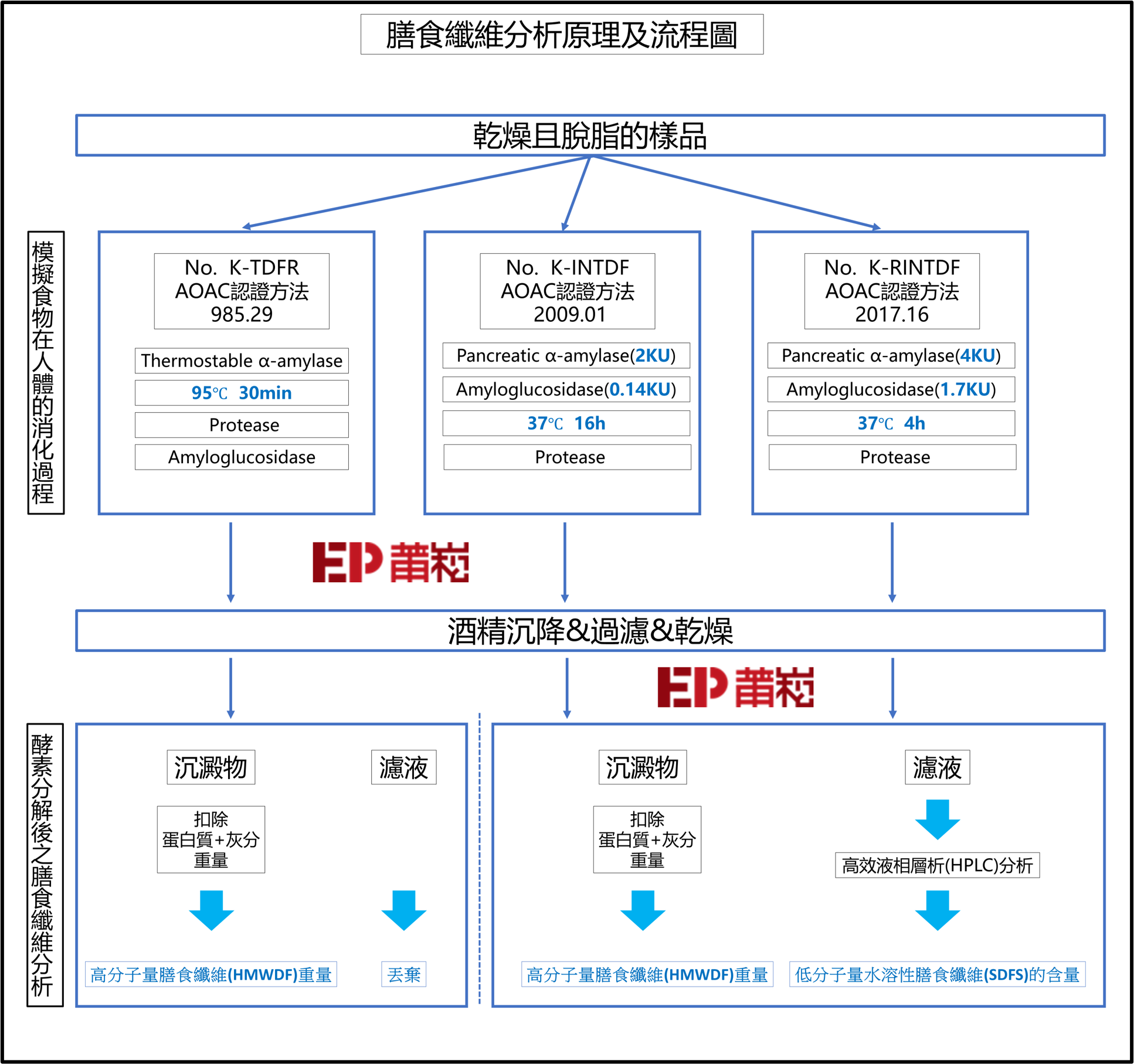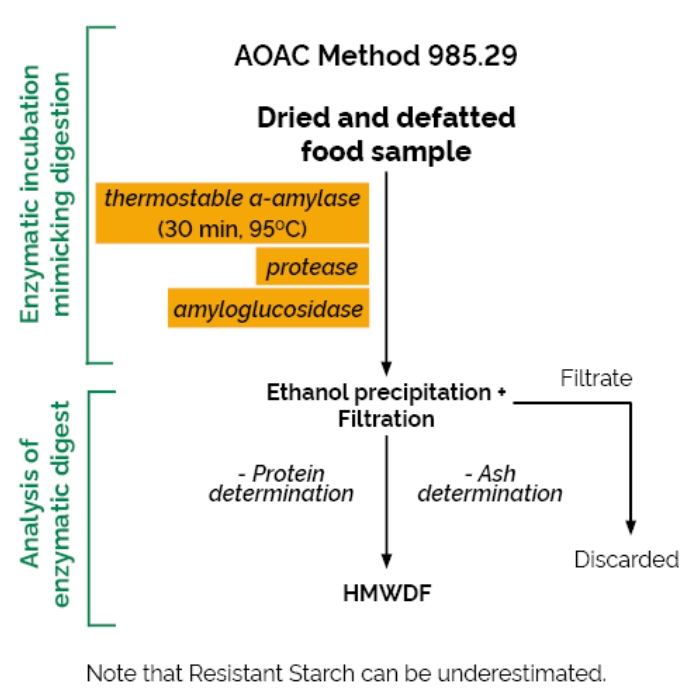- 背景資料
現行衛福部對膳食纖維的定義為:⌈人體小腸無法消化與吸收之三個以上單醣聚合之可食碳水化合物及木質素⌋
故膳食纖維涵蓋範圍廣泛,依據其不同的化學性質或分類方式,可大致分成以下幾類:
1️⃣抗性澱粉(Resistant Starch,簡稱RS),可分成5類,分別為RS1、RS2、RS3、RS4、RS5
2️⃣高分子量膳食纖維 (High Molecular Weight Dietary Fiber,簡稱HMWDF),此類別又可分成
➡️➡️非水溶性膳食纖維( Insoluble Dietary Fiber,簡稱 IDF)
➡️➡️高分子量水溶性膳食纖維(水溶但78%酒精不可溶)(Soluble Dietary Fiber which precipitates in 78% ethanol,High Molecular Weight Soluble Dietary Fiber,簡稱SDFP或HMWSDF)
3️⃣低分子量水溶性膳食纖維(水溶且78%酒精也可溶)( Soluble Dietary Fiber that remains soluble in 78% ethanol,non-digestible oligosaccharides,Low Molecular Weight Soluble Dietary Fiber,簡稱SDFS或NDO或LMWSDF)
⚠️備註⚠️
➡️樣品中如有抗性澱粉,可能會影響此套組之實驗結果
➡️低分子量水溶性膳食纖維需透過高效液相層析(HPLC)分析後,方可定量
➡️高分子量膳食纖維(HMWDF)=非水溶性膳食纖維(IDF) + 高分子量水溶性膳食纖維(SDFP)
➡️樣品中的總膳食纖維(Total dietary fiber ,簡稱TDF)=高分子量膳食纖維(HMWDF)+低分子量水溶性膳食纖維(LMWSDF)
AOAC Method 985.29➡️此套組之總膳食纖維檢測,主要以高分子量膳食纖維(HMWDF)為主,低分子量水溶性膳食纖維(SDFS)未納入
AOAC Method 991.43➡️此套組之水溶性膳食纖維檢測,主要以高分子量水溶性膳食纖維(SDFP)為主,低分子量水溶性膳食纖維(SDFS)未納入
.jpg)


-
AOAC Method 985.29 操作方法
(DETERMINATION OF TOTAL DIETARY FIBER)
Run blank through entire procedure along with samples to measure any contribution from reagents to residue.
1. Weigh duplicate 1 g samples, accurate to 0.1 mg, into 400 mL tall-form beakers. Sample weights should differ by less than 20 mg from each other. Add 50 mL phosphate buffer (pH 6.0) to each beaker and check pH with pH meter. Adjust if pH does not equal 6.0±0.1.
2. Add 50 µL heat-stable α-amylase solution.
3. Cover beaker with aluminium foil and place in boiling water bath. Beaker must be incubated at 98-100°C for 15 min. Shake gently at 5 min intervals.
Note: Increase incubation time when number of beakers in bath makes it difficult for beaker contents to reach internal temperature of 98-100°C. Use thermometer to indicate that 15 min at 98-100°C is attained. Total of 30 min in boiling water bath should be sufficient.
4. Cool solutions to room temperature.
5. Adjust to pH 7.5±0.1 by adding 10 mL 0.275 N NaOH solution. Check pH with pH meter.
6. Add 100 µL of protease solution.
7. Cover beaker with aluminium foil and incubate at 60°C with continuous agitation for 30 min.
8. Cool and add 10 mL 0.325 N HCl solution to adjust pH to 4.5±0.2. Check pH with pH meter.
9. Add 200 µL amyloglucosidase, cover with aluminium foil, and incubate for 30 min at 60°C with continuous agitation.
10. Add 280 mL 95% EtOH pre-heated to 60°C (measure volume before heating). Let precipitate form at room temperature for 60 min.
11. Weigh crucible containing Celite to nearest 0.1 mg, then wet and distribute bed of Celite in crucible by using stream of 78% EtOH from wash bottle.
12. Apply suction to draw Celite onto fritted glass as even mat. Maintain suction and quantitatively transfer precipitate from enzyme digest to crucible.
13. Wash residue successively with three 20 mL portions of 78% EtOH, two 10 mL portions of 95% EtOH, and two 10 mL portions of acetone. In some cases, gums may form during filtration, trapping liquid in residue. If so, break surface film with spatula to improve filtration. Long filtration times can be avoided by careful intermittent suction throughout filtration.
14. Dry crucible containing residue overnight in 70°C vacuum oven or 105°C air oven.
15. Cool in desiccator and weigh to nearest 0.1 mg. Subtract crucible and Celite weights to determine weight of residue.
16. Analyse residue from one sample of set of duplicates for protein by AACC Method 46-13, using N x 6.25 as conversion factor.
17. Incinerate second residue sample of duplicate for 5 h at 525°C. Cool in desiccator and weigh to 0.1 mg. Subtract crucible and Celite weights to determine ash.
- AOAC Method 991.43 操作方法
(DETERMINATION OF TOTAL, SOLUBLE AND INSOLUBLE DIETARY FIBER)
1. Blanks
With each assay, run two blanks along with samples to measure any contribution from reagents to residue.
2. Samples
a. Weigh duplicate 1.000±0.005 g samples accurately into 400 mL tall-form beakers.
b. Add 40 mL MES-TRIS blend buffer solution (pH 8.2) to each beaker. Add magnetic stirring bar to each beaker. Stir on magnetic stirrer until sample is completely dispersed in solution (this prevents lump formation, which would make sample inaccessible to enzymes).
3. Incubation with heat-stable α-amylase
a. Add 50 µL heat-stable α-amylase solution, while stirring at low speed.
b. Cover each beaker with aluminium foil squares.
c. Place covered samples in shaking water bath at 98-100°C and incubate for 30 min with continuous agitation. Start timing once all beakers are in hot water bath.
4. Cool
a. Remove all sample beakers from hot water bath and cool to 60°C.
b. Remove foil covers.
c. Scrape any ring around beaker and gels in bottom of beaker with spatula, if necessary.
d. Rinse side wall of beaker and spatula with 10 mL distilled water by using pipettor.
e. Adjust temperature of water bath to 60°C by draining some of hot water from water bath and adding cold water.
5. Incubation with protease
a. Add 100 µL protease solution to each sample.
b. Re-cover with aluminium foil.
c. Incubate in shaking water bath at 60±1°C, with continuous agitation for 30 min. Start timing when temperature of water bath reaches 60°C.
6. pH check
a. Remove sample beakers from shaking water bath.
b. Remove covers.
c. Dispense 5 mL of 0.561 N HCl solution into sample while stirring.
d. Check pH, which should be 4.1-4.8. Adjust pH, if necessary, with additional 5% NaOH solution or 5% HCl solution (see Note 2, page 10).
7. Incubation with amyloglucosidase
a. Add 200 µL amyloglucosidase solution while stirring on magnetic stirrer.
b. Replace aluminium cover.
c. Incubate in shaking water bath at 60°C for 30 min with constant agitation. Start timing when temperature of water bath reaches 60°C.
A. INSOLUBLE DIETARY FIBER
8. Filtration setup
a. Tare crucible containing Celite to nearest 0.1 mg.
b. Wet and redistribute bed of Celite in crucible using approx. 3 mL distilled water.
c. Apply suction to crucible to draw Celite onto fritted glass as an even mat.
9. Filter enzyme mixture from Step 7 through crucible into a filtration flask.
10. Wash residue twice with 10 mL distilled water pre-heated to 70°C. Use water to rinse beaker before washing residue in crucible. Save filtrate and water washings for determination of SDF. Transfer solution to a pre-tared 600 mL tall-form beaker (for SDF determination, go to Step 11 of SDF procedure, page 8).
11. Wash residue twice with 10 mL of:
a. 95% EtOH
b. Acetone
12. Dry crucible containing residue overnight in 103°C oven.
13. Cool crucible in desiccator for approx. 1 h. Weigh crucible containing dietary fiber residue and Celite to nearest 0.1 mg. To obtain residue weight, subtract tare weight, i.e. weight of dried crucible and Celite.
14. Protein and ash determination. One residue from each type of fiber is analysed for protein and the second residue of the duplicate is analysed for ash.
a. Perform protein analysis on residue using Kjeldahl method. Use 6.25 factor for all cases to calculate g of protein.
b. For ash analysis, incinerate the second residue for 5 h at 525°C. Cool in desiccator and weigh to nearest 0.1 mg. Subtract crucible and Celite weight to determine ash content (see Note 3, page 10).
B. SOLUBLE DIETARY FIBER
1-10. Follow Steps 1-10 of IDF method.
11. Weigh combined solution of filtrate and water washings in pre-tared beaker from Step 10 of IDF procedure.
12. Precipitation of SDF
a. Add 4 vols 95% EtOH pre-heated to 60°C. Use a portion of EtOH to rinse filtering flask from IDF procedure (step 10). Alternatively, adjust weight of combined solution of filtrate and water washings to 80 g and add 320 mL of pre-heated (60°C) 95% EtOH.
b. Allow the precipitate to form at room temperature for 60 min.
13. Filtration setup
a. Tare crucible containing Celite to nearest 0.1 mg.
b. Wet and redistribute the bed of Celite in the crucible, using 15 mL of 78% EtOH from wash bottle.
c. Apply suction to crucible to draw Celite onto fritted glass as an even mat.
14. Filtration
a. Filter precipitated enzyme digest from SDF Step 12 through crucible.
b. Using a wash bottle with 78% EtOH and a rubber spatula, quantitatively transfer all remaining particles to crucible.
15. Wash Using a vacuum, wash residue successively with two 15 mL portions of the following: (see Note 4, page 10).
a. 78% EtOH
b. 95% EtOH
c. Acetone
16. Dry crucible containing residue overnight in 103°C oven.
17. Proceed with Steps 13 and 14 of IDF method.
C. TOTAL DIETARY FIBER
1-7. Follow Steps 1-7.
8. Precipitation of dietary fiber with EtOH.
a. To each sample, add 225 mL 95% EtOH pre-heated to 60°C. Measure volume after heating. Ratio of EtOH volume to sample volume should be 4:1. If 95% EtOH is accidentally over-heated to 65°C, add 228 mL for expanded alcohol volume adjustment.
b. Cover all samples with large sheets of aluminium foil.
c. Allow precipitate to form at room temperature for 60 min.
9. Proceed with Steps 13-17 of SDF procedure.
商品特色
商品規格
- 商品規格(100/200個檢測反應)
- 100個檢測反應套組(100 determinations assay kit)
Bottle 1:
Thermostable α-amylase
(10 mL, ~ 3,000 U/mL (Ceralpha method); ~ 10,000 U/mL on soluble starch)
(Megazyme cat. no. E-BLAAM).
Bottle 2:
Purified protease
(10 mL, 50 mg/mL; ~ 350 tyrosine U/mL)
(Megazyme cat. no. E-BSPRT).
Bottle 3:
Purified amyloglucosidase
(20 mL, 3,300 U/mL on soluble starch)
(Megazyme cat. no. E-AMGDF).
- 200個檢測反應套組(200 determinations assay kit)
Bottle 1:
Thermostable α-amylase
(20 mL, ~ 3,000 U/mL (Ceralpha method); ~ 10,000 U/mL on soluble starch)
(Megazyme cat. no. E-BLAAM).
Bottle 2:
Purified protease
(20 mL, 50 mg/mL; ~ 350 tyrosine U/mL)
(Megazyme cat. no. E-BSPRT).
Bottle 3: (*2)
Purified amyloglucosidase
(20 mL, 3,300 U/mL on soluble starch)
(Megazyme cat. no. E-AMGDF).


